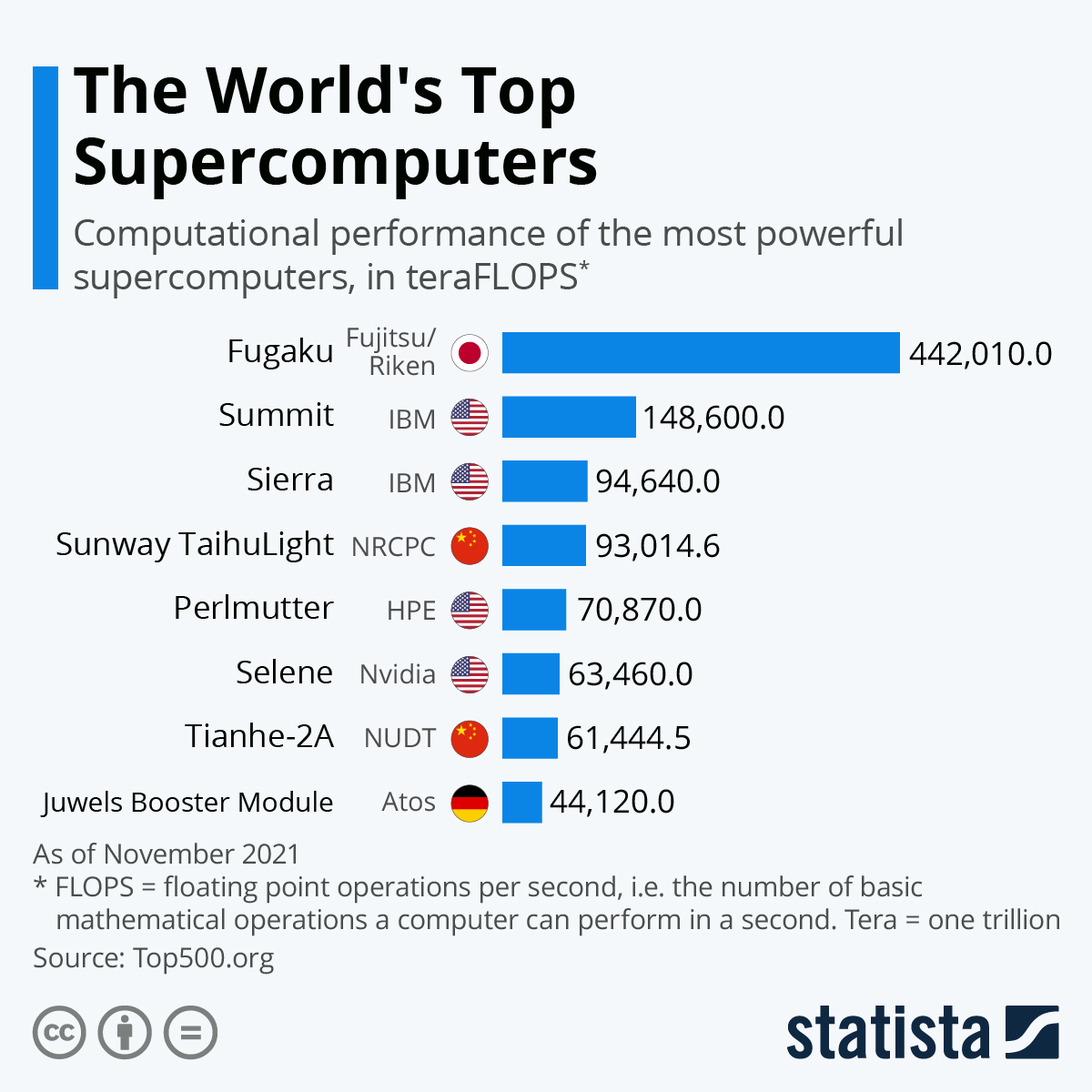From ZH, June 28:
Japanese supercomputer Fugaku zipped past all competitors to claim the top spot in the twice-annual ranking of the world's most powerful computational machines released by research project Top500.
You will find more infographics at Statista
Statista's Katharina Buchholz reports that Fugaku, which was developed by Fujitsu in cooperation with the federal Riken research lab, was able to perform almost three times as many computations per second as former leader of the list, U.S.-based supercomputer Summit.
Fugaku has not only topped the ranking in the number of computations per second - so-called TeraFLOPS - but in all four categories that supercomputers are judged on by the project. According to the Riken lab, no other computer had achieved this feat so far. Fugaku also had the most cores of all computers ranked, the highest theoretical peak performance for computations and the highest power capacity....MORELooking at the June 2019 list:
World's Fastest Supercomputers: "The 53rd TOP500 List Was Published in Frankfurt June 18" (NVDA)
Five of the ten fastest computers in the world are using NVIDIA GPU's as accelerators, clocking in at 1st, 2nd, 6th, 8th and 10th fastest.
And this year's Top 500, June 2020, it looks like six of the top 10 fastest in the world 'puters are using NVDA GPU's as accelerators:
.
The 55th edition of the TOP500 saw
some significant additions to the list, spearheaded by a new number one
system from Japan. The latest rankings also reflect a steady growth in
aggregate performance and power efficiency.
The new top system, Fugaku, turned in a High Performance Linpack (HPL) result of 415.5 petaflops, besting the now second-place Summit system by a factor of 2.8x. Fugaku, is powered by Fujitsu’s 48-core A64FX SoC, becoming the first number one system on the list to be powered by ARM processors. In single or further reduced precision, which are often used in machine learning and AI applications, Fugaku’s peak performance is over 1,000 petaflops (1 exaflops). The new system is installed at RIKEN Center for Computational Science (R-CCS) in Kobe, Japan.Number two on the list is Summit, an IBM-built supercomputer that delivers 148.8 petaflops on HPL. The system has 4,356 nodes, each equipped with two 22-core Power9 CPUs, and six NVIDIA Tesla V100 GPUs. The nodes are connected with a Mellanox dual-rail EDR InfiniBand network. Summit is running at Oak Ridge National Laboratory (ORNL) in Tennessee and remains the fastest supercomputer in the US.At number three is Sierra, a system at the Lawrence Livermore National Laboratory (LLNL) in California achieving 94.6 petaflops on HPL. Its architecture is very similar to Summit, equipped with two Power9 CPUs and four NVIDIA Tesla V100 GPUs in each of its 4,320 nodes. Sierra employs the same Mellanox EDR InfiniBand as the system interconnect.Sunway TaihuLight, a system developed by China’s National Research Center of Parallel Computer Engineering & Technology (NRCPC) drops to number four on the list. The system is powered entirely by Sunway 260-core SW26010 processors. Its HPL mark of 93 petaflops has remained unchanged since it was installed at the National Supercomputing Center in Wuxi, China in June 2016.At number five is Tianhe-2A (Milky Way-2A), a system developed by China’s National University of Defense Technology (NUDT). Its HPL performance of 61.4 petaflops is the result of a hybrid architecture employing Intel Xeon CPUs and custom-built Matrix-2000 coprocessors. It is deployed at the National Supercomputer Center in Guangzhou, China.A new system on the list, HPC5, captured the number six spot, turning in an HPL performance of 35.5 petaflops. HPC5 is a PowerEdge system built by Dell and installed by the Italian energy firm Eni S.p.A, making it the fastest supercomputer in Europe. It is powered by Intel Xeon Gold processors and NVIDIA Tesla V100 GPUs and uses Mellanox HDR InfiniBand as the system network.Another new system, Selene, is in the number seven spot with an HPL mark of 27.58 petaflops. It is a DGX SuperPOD, powered by NVIDIA’s new “Ampere” A100 GPUs and AMD’s EPYC “Rome” CPUs. Selene is installed at NVIDIA in the US. It too uses Mellanox HDR InfiniBand as the system network.Frontera, a Dell C6420 system installed at the Texas Advanced Computing Center (TACC) in the US is ranked eighth on the list. Its 23.5 HPL petaflops is achieved with 448,448 Intel Xeon cores.
....MUCH MUCH MOREThe second Italian system in the top 10 is Marconi-100, which is installed at the CINECA research center. It is powered by IBM Power9 processors and NVIDIA V100 GPUs, employing dual-rail Mellanox EDR InfiniBand as the system network. Marconi-100’s 21.6 petaflops earned it the number nine spot on the list.Rounding out the top 10 is Piz Daint at 19.6 petaflops, a Cray XC50 system installed at the Swiss National Supercomputing Centre (CSCS) in Lugano, Switzerland. It is equipped with Intel Xeon processors and NVIDIA P100 GPUs.
Piz Daint is the computer the Swiss let CERN use if they have a mind-bendingly complex operation they need to run
We mentioned their Nvidia upgrade in 2017's "Supercomputers 'The 49th TOP500 List was published June 20, 2017 in Frankfurt, Germany.'" as well as Nvidia's own supercomputer which is now #23 in the world, moving up from #28.
